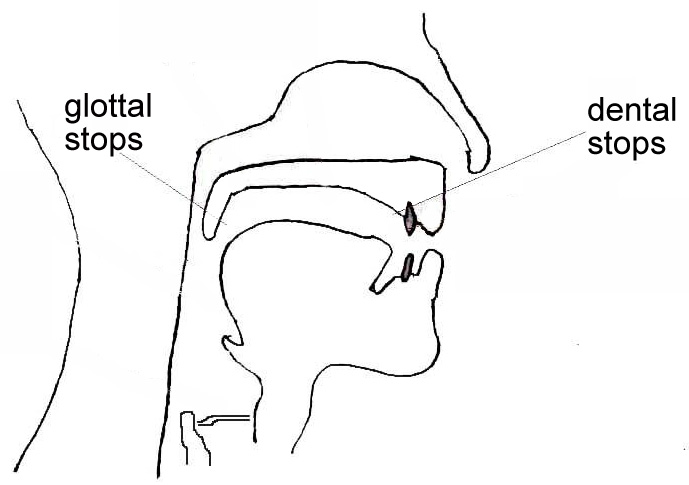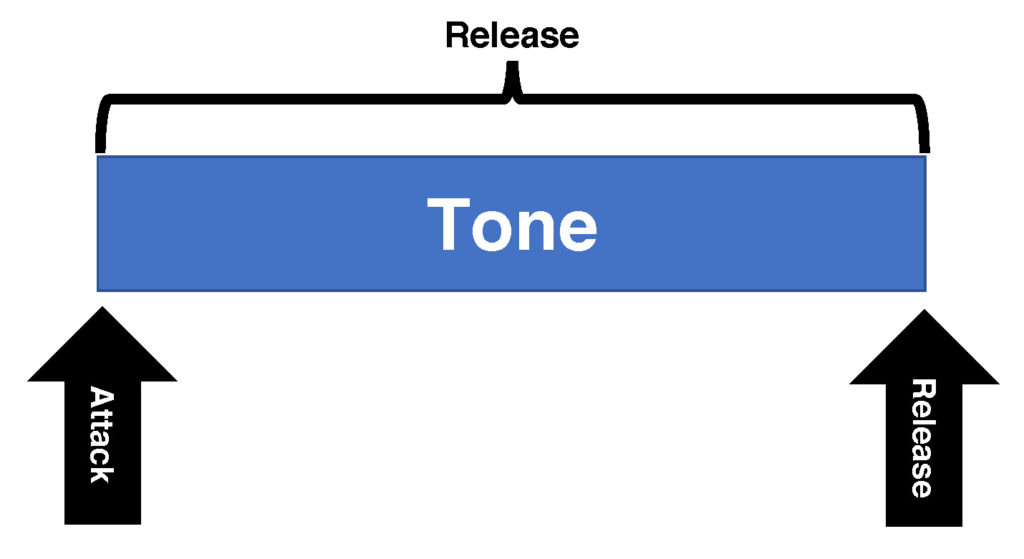7 Articulation on Brass Instruments
Articulation on wind instruments refers to the use of the tongue to start and occasionally stop the airstream. Typically, brass players use dental stops, which places the tongue against the base of the upper palate at the top of the teeth. They typically use the syllable tu or du to articulate a note.
In a few specialized techniques, specifically double tonguing, a glottal stop is used. For glottal stops, the tongue rocks back in the mouth to meet the soft palate at the top of the throat. The syllable gu or ku are used to articulate these techniques.

It is critically important that the tongue quickly flick into the air stream and then return to a neutral “Ah” or “Oh” position. The articulation should merely interrupt the flow of the air to create separation of consecutive pitch, not bring the air stream to a full stop. An imperfect visualization is a hand slipping through a stream of water. The water does not come to a full stop: rather, it is merely interrupted.
Parts of an Articulation
Each articulation has three parts that are treated differently dependent on the interpretive intent of the articulation.

The attack initiates the tone and is controlled by the tongue. The choice of starting consonant dictates the intensity of the articulation attack. Tu provides a stronger attack. Du provides a more legato attack. Lu is used by trombonists to mask slide movement to create an extremely light articulation. To play slurs, no tongue is used, allowing the air to move without interruption from one note to the next.
The sustain is the tone itself and is largest controlled by the space in the oral cavity. When the tongue is placed higher in the mouth, using an Eeee (as in mEEt or IPA: i) or Ahhh (as in fAther or IPA: a) vowel, the tone is brighter and more direct. When a more open vowel such as Ooo (as in shOE or IPA: Ʊ) or Ohhh (as in rOW or IPA: u) is used, the sustained tone is darker and fuller.
The release is the end of the note. For nearly all standard articulations (marcato is the one exception), the tongue is not engaged for the release of the note. For connected notes, the attack of the following note serves as the release of the previous tone. For notes with separation, the air column remains engaged between notes but a soft glottal stop of h is used to hold the air.
Importantly, after ever attack, the tongue returns to a neutral position at the bottom of the mouth. While the vowel shape may vary with brighter vowels for higher notes and darker vowels for lower notes, care should be made to make sure that the tip of the tongue moves quickly down from the top of the mouth.
Initial Exercises for Articulation
Speak and Play-Have students vocally practice articulations and then imitate them in performance. Start with four notes of even duration and the same pitch. With a metronome, say “Tah, Tah, Tah, Tah,” set the mouthpiece, and play. When students are speaking, make sure they are using the same consonant and vowel with each note. As they play, make sure that the tone starts immediately with the first note and that the tone stays consistent from one note to the next. VIDEO
Legato Articulation-Have students first focus on clear legato playing. This is the foundation of brass articulation. The initial attack should be played clearly without surging the sustain that follows. The goal is consistency of attack and sustain with each note. Once repeated legatos can be played on a repeated note at the same rate, the rate should be increased or scale patterns can be added to increase complexity.
Melodies by ear-Have students learn simple melodies by ear. While the play, focus on their consistent use of legato articulation and consistency of sustained tone.
Call and Response Patterns-Play short 4 note patterns using legato articulation for students to hear and then respond to. At first, the teacher should provide these patterns, but students should quickly assume the responsibility of pattern maker. The teacher can put parameters on what is played (e.g. all notes must be of the same length or notes must be selected from a specific key). As students play, listen carefully for consistency of pitch and attack. As students become more adept at imitative performance and articulation, variations can be included in this activity by extending the length of the played pattern.
Common Articulation Issues
Slow/heavy tongue-Articulation should interrupt the air flow very quickly with just the tip of the tongue fully stopping the air flow. If too much of the tongue is used, the articulation will become slow and the air will be stifled, creating lack of clarity in the attack of the tone and instability in the sustain. Often, students are trying to articulate too heavily. To remedy this issue, have the students vocally articulate before playing using the Speak and Play activity. For students with heavy tonguing, encourage them to think Dah instead of Tah to lighten the weight of the tongue. Incorrect modeling is also a good technique by having students use the wrong syllables. Start with “Nah, Nah, Nah, Nah” followed by “Dah, Dah, Dah, Dah.”
Tongue between teeth/Embouchure “tonguing”-It is not uncommon for students to use their lips and jaw to articulate notes, using a pa or ma syllable. This creates issues for tone production as it introduces tension in the middle of the embouchure and distorts the tone of the subsequent sustain. Similarly, many students will over use the tongue, pushing it between the teeth using a tha syllable, causing the jaw to move as they play, again destabilizing the embouchure. To remedy this issue, return to Speak and Play activities, emphasizing good tone on every tone. VIDEO for 1 & 2
Uneven articulations-Students will often become sloppy in their articulations as more elements are introduced into their performance, such as new notes, faster passages, and expressive markings. When this occurs, their tongue placement becomes irregular, either by not using the same syllable for all articulations or not allowing the tongue to fully return to a neutral position. Simplification of task is critically important for this student. Simplification can mean many things: slower tempo, less demanding technical demand, less attention to expressive markings, etc. Once the student has demonstrated consistent articulation, begin to reintroduce more complexity.
Weak starting articulations-Timing is a critical element for articulation, and this becomes very apparent with first note articulation. The air and the tongue need to be timed perfectly with one another. If the tongue is moving early, the articulation will be weak or non-existent followed by a wah start to the note as the air becomes full. The tongue is needed to support the clear attack of first notes. If the tongue is moving too late, the note will have a double attack with the first established by air and the second established by the tongue. To work on this issue, have students practice starting and stopping to make sure that they can time the air and the tongue together. VIDEO
Articulation Details
All articulations are a variation on the same basic articulation concepts:
- A clear attack using a dah or tah syllable with the tongue
- A consistent sustain without tension using an open vowel (usually ahhh (IPA: a) or ooo (IPA: Ʊ) )
- An open air release without tongue movement, ending with an h consonant
With that said, each notated articulation has slightly different conventions:
Legato/Tenuto-Follows the basic articulation concepts listed above. The attack of the following note is the release of the previous. Legato and tenuto typically use a dah articulation.
Accent-The attack of the note is stronger, using a tah articulation. Because of the heavy attack, care needs to be made to not distort the sustain that follows. In some cases, air usage may be increased for the attack, especially when additional markings (e.g. fp, sfz) are included.
Staccato-The attack is typically light, using a dah syllable. Because of the shortened sustain and separation from the following note, the back of the tongue rises slightly for the release to allow the air column to remain engaged without producing additional sound.
Marcato-The attack is similar to the accent in its use of a strong tah articulation. The sustain is shortened like in the staccato. The release can be (especially in jazz and global music styles like Mariachi and Romani music) be tongue stopped, using a taht syllable.
Brass instruments also utilize a variety of other advanced articulations, such as multiple tonguing, flutter tonguing, and growling. More details on these advanced techniques can be found in Advanced Techniques.
Exercises for Developing Articulation Contrast for Beginners
Articulation Contrast Studies–When first introducing contrasting articulations, students should isolate each type of articulation on a single pitch over a repeated rhythm. Emphasis should be placed on articulation consistency and quality tone. Once the students can play with consistent, high quality tone and articulation, they should alternate different articulations, emphasizing the contrasts between them.
Change It Up-One student starts with a simple musical pattern or melody. The students then pass it around by playing the same notes but altering the articulation to create a different interpretation. As they play, they can alter the articulation however they wish, but should play with consistent articulation and quality tone.

